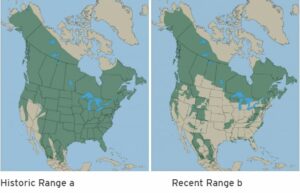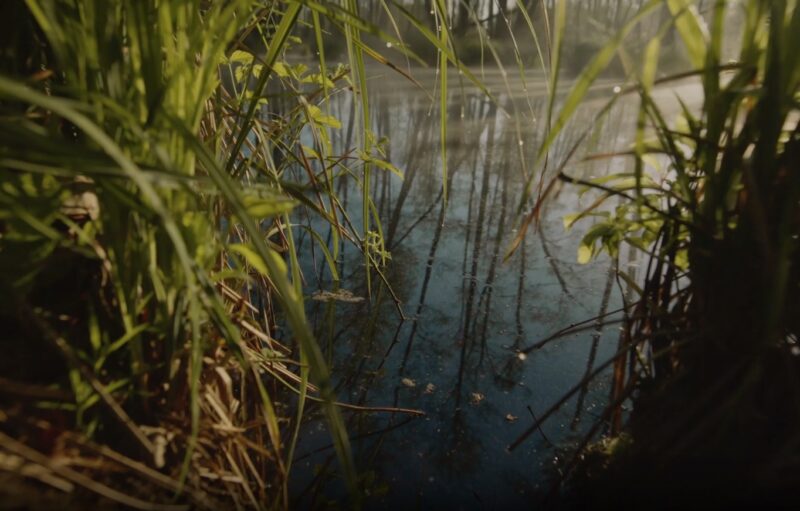Great climber, a good swimmer, and yet – a very solid runner (40-50kph). Yes, we mean on black bear.
The American black bear, normally just referred to as ‘black bear’ in North America, is one of three bear species found on this vast continent, along with the grizzly bear (the American subspecies of brown bear) and polar bear.
Of the three, the black bear is the most commonly encountered and is distributed across most of the USA and Canada.
Black bears are only found in North America. The species ranges from Canada in the north to Mexico in the south, and lives predominantly in forests, feeding on fruit, nuts, shoots, and vegetation.
Across their entire range throughout North America, black bears are thought to have a total population of around 800,000.
Historically range
Black bears historically ranged over most of the forested regions of North America, including all Canadian provinces, Alaska, all states in the conterminous United States, and significant portions of northern Mexico (Hall 1981).
Their current distribution is restricted to relatively undisturbed forested regions (Pelton 1982; Pelton et al. 1994).

Regions where still live
Black bears can still be found throughout Canada with the exception of Prince Edward Island (extirpated in 1937), and in at least 40 of the 50 states; their status in Mexico is uncertain (Leopold 1959).
In the eastern United States black bear range is continuous throughout New England but becomes increasingly fragmented from the mid-Atlantic down through the Southeast (Maehr 1984).
In the Southeast, most populations are now restricted to the Appalachian mountain chain or coastal areas intermittently in all states from Virginia to Louisiana (J. Wooding, Florida Freshwater Fish and Game Commission, unpublished data).
| Year | Location | Strange places where bears spotted |
|---|---|---|
| 2019 | Hendersonville, North Carolina | Around a residential neighborhood. The bear was seen walking through yards and crossing streets before eventually climbing a tree and being tranquilized by wildlife officials. |
| 2018 | Cape May, New Jersey | On the beach. The bear was seen wandering along the shoreline and was eventually chased back into the woods by police. |
| 2017 | University of Colorado, Boulder | On the campus. The bear was seen wandering around a parking lot and was eventually tranquilized and relocated by wildlife officials. |
| 2016 | United States Military Academy at West Point, New York | On the grounds. The bear was seen wandering around a housing area and was eventually tranquilized and relocated by wildlife officials. |
| 2015 | Asheville, North Carolina | On the 16th hole of a golf course. The bear was seen wandering around the course and was eventually chased away by golfers. |
| 2014 | Lake Tahoe, California | On the slopes of a ski resort. The bear was seen wandering around the resort and was eventually chased away by ski patrol. |
| 2013 | Anchorage, Alaska | Tree in a residential neighborhood. The bear was seen lounging in the tree and was eventually tranquilized and relocated by wildlife officials. |
| 2012 | Denver, Colorado | Tree in a residential neighborhood. The bear was seen lounging in the tree and was eventually tranquilized and relocated by wildlife officials. |
| 2011 | Seattle, Washington | Tree in a residential neighborhood. The bear was seen lounging in the tree and was eventually tranquilized and relocated by wildlife officials. |
| 2010 | Minneapolis, Minnesota | Tree in a residential neighborhood. The bear was seen lounging in the tree and was eventually tranquilized and relocated by wildlife officials. |
They are in the east, along the west coast, in the Rocky Mountains, and parts of Alaska.
They are also found in a few small areas in the southwest and southeast.
Black bears are the most timid and least dangerous of the bears found in North America.
5. Tongass National Forest, Alaska
Most people travel to Alaska to see brown and polar bears, so a place where black bears are the center of attention is unusual.
But this is the case at the Anan Wildlife Observatory in Tongass National Forest.
In July and August, black bears gather at a waterfall just below a viewing platform to feed on spawning pink salmon. For the best experience, stay overnight at the Anan Bay Cabin.
4. Tofino, British Columbia
On the west coast of Vancouver Island, Tofino offers a fantastic wilderness adventure and the densest populations of black bears in the world.
In mid-summer, they can easily be seen on the rocky foreshores, where they wander at low tide to feast on crabs and fish. Orcas and grey and humpback whales are also common.
3. Yellowstone National Park, Wyoming, Montana and Idaho
Yellowstone National Park is the only place where you can easily see black bears amid other charismatic wildlife such as bison, elk, moose, grizzlies, and wolves.
But this is a huge park, so it helps to hire a wildlife expert as your guide.
2. Great Smoky Mountains National Park, North Carolina and Tennessee
The deciduous forests of Great Smoky Mountains National Park are among the best places to spot black bears in the eastern USA.
Though the park has a high density of bears, they can be skittish and difficult to watch – except along Cades Cove Loop Road, an old homestead area with relict orchards, fruit trees, and open meadows, which attracts lots of bears between April and October.
1. Alligator River National Wildlife Refuge, North Carolina
Alligator River was established on the North Carolina seashore to protect a remnant of the unique wetland habitat called ‘pocosin’, but it is also one of the last remaining strongholds for black bears on the Eastern Seaboard.
In the Milltail section of the refuge, black bears wander out from swampy thickets to feed in nearby fields, and in summer you can join a ‘sunset tour’ that includes an opportunity to see bears at night. Alternatively, drive the Milltail Road on your own.
References
Hall, E.R. 1981. The mammals of North American 2nd ed. John Wiley and Sons. New York. 1.181 pp.
Leopold, A.S. 1959. Wildlife of Mexico. University of California Press. Berkley. 608 pp.
Maehr, D.S. 1984. Distribution of black bears in eastern North America. Eastern Workshop on Black Bear Research and Management 7:74.
Pelton, M.R. 1982. Black bear. Pages 504-514 in J.A. Chapman and G.A. Feldhamer, eds. Wild mammals of North America: biology, management, and economics. John Hopkins University Press. Baltimore and London.
Pelton, M.R., F. vanManen, A. Coley, K. Weaver, J. Pedersen, and T. Eason. 1994. Black bear conservation action plan—North America. IUCN/SSC Bear Specialist Group Tech. Rep. In press.
Range Map Notes
a modified from Hall 1981
b based on survey responses from provinces and states (Pelton 1994) and research projects in Mexico (D. Doan, Texas A & I Univ., pers. comm.)








